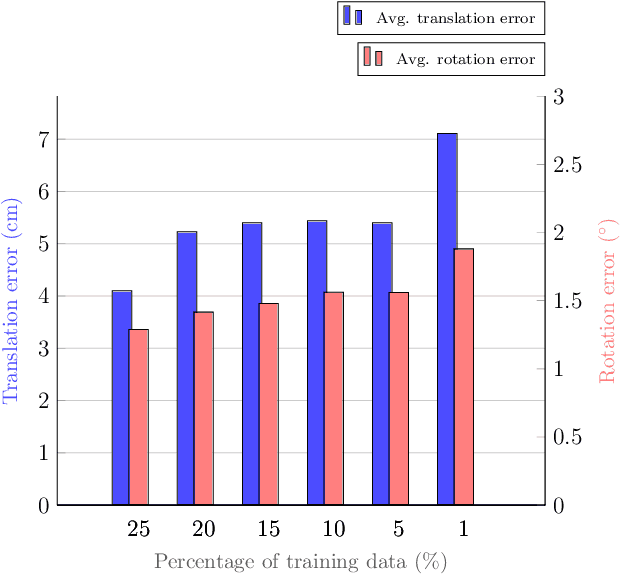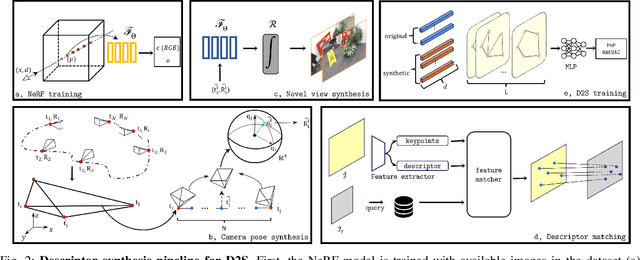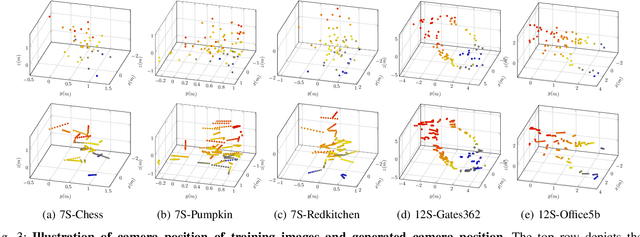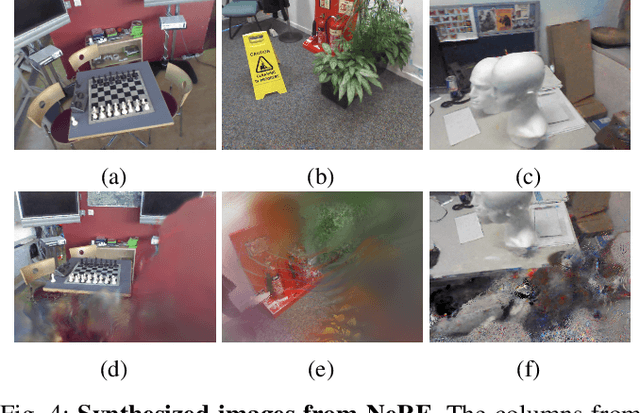Joo-Ho Lee
When Less Is More: A Sparse Facial Motion Structure For Listening Motion Learning
Apr 08, 2025Abstract:Effective human behavior modeling is critical for successful human-robot interaction. Current state-of-the-art approaches for predicting listening head behavior during dyadic conversations employ continuous-to-discrete representations, where continuous facial motion sequence is converted into discrete latent tokens. However, non-verbal facial motion presents unique challenges owing to its temporal variance and multi-modal nature. State-of-the-art discrete motion token representation struggles to capture underlying non-verbal facial patterns making training the listening head inefficient with low-fidelity generated motion. This study proposes a novel method for representing and predicting non-verbal facial motion by encoding long sequences into a sparse sequence of keyframes and transition frames. By identifying crucial motion steps and interpolating intermediate frames, our method preserves the temporal structure of motion while enhancing instance-wise diversity during the learning process. Additionally, we apply this novel sparse representation to the task of listening head prediction, demonstrating its contribution to improving the explanation of facial motion patterns.
A-SCoRe: Attention-based Scene Coordinate Regression for wide-ranging scenarios
Mar 18, 2025Abstract:Visual localization is considered to be one of the crucial parts in many robotic and vision systems. While state-of-the art methods that relies on feature matching have proven to be accurate for visual localization, its requirements for storage and compute are burdens. Scene coordinate regression (SCR) is an alternative approach that remove the barrier for storage by learning to map 2D pixels to 3D scene coordinates. Most popular SCR use Convolutional Neural Network (CNN) to extract 2D descriptor, which we would argue that it miss the spatial relationship between pixels. Inspired by the success of vision transformer architecture, we present a new SCR architecture, called A-ScoRe, an Attention-based model which leverage attention on descriptor map level to produce meaningful and high-semantic 2D descriptors. Since the operation is performed on descriptor map, our model can work with multiple data modality whether it is a dense or sparse from depth-map, SLAM to Structure-from-Motion (SfM). This versatility allows A-SCoRe to operate in different kind of environments, conditions and achieve the level of flexibility that is important for mobile robots. Results show our methods achieve comparable performance with State-of-the-art methods on multiple benchmark while being light-weighted and much more flexible. Code and pre-trained models are public in our repository: https://github.com/ais-lab/A-SCoRe.
Improved 3D Point-Line Mapping Regression for Camera Relocalization
Feb 28, 2025Abstract:In this paper, we present a new approach for improving 3D point and line mapping regression for camera re-localization. Previous methods typically rely on feature matching (FM) with stored descriptors or use a single network to encode both points and lines. While FM-based methods perform well in large-scale environments, they become computationally expensive with a growing number of mapping points and lines. Conversely, approaches that learn to encode mapping features within a single network reduce memory footprint but are prone to overfitting, as they may capture unnecessary correlations between points and lines. We propose that these features should be learned independently, each with a distinct focus, to achieve optimal accuracy. To this end, we introduce a new architecture that learns to prioritize each feature independently before combining them for localization. Experimental results demonstrate that our approach significantly enhances the 3D map point and line regression performance for camera re-localization. The implementation of our method will be publicly available at: https://github.com/ais-lab/pl2map/.
PainDiffusion: Can robot express pain?
Sep 18, 2024



Abstract:Pain is a more intuitive and user-friendly way of communicating problems, making it especially useful in rehabilitation nurse training robots. While most previous methods have focused on classifying or recognizing pain expressions, these approaches often result in unnatural, jiggling robot faces. We introduce PainDiffusion, a model that generates facial expressions in response to pain stimuli, with controllable pain expressiveness and emotion status. PainDiffusion leverages diffusion forcing to roll out predictions over arbitrary lengths using a conditioned temporal U-Net. It operates as a latent diffusion model within EMOCA's facial expression latent space, ensuring a compact data representation and quick rendering time. For training data, we process the BioVid Heatpain Database, extracting expression codes and subject identity configurations. We also propose a novel set of metrics to evaluate pain expressions, focusing on expressiveness, diversity, and the appropriateness of model-generated outputs. Finally, we demonstrate that PainDiffusion outperforms the autoregressive method, both qualitatively and quantitatively. Code, videos, and further analysis are available at: \href{https://damtien444.github.io/paindf/}{https://damtien444.github.io/paindf/}.
Leveraging Neural Radiance Field in Descriptor Synthesis for Keypoints Scene Coordinate Regression
Mar 20, 2024



Abstract:Classical structural-based visual localization methods offer high accuracy but face trade-offs in terms of storage, speed, and privacy. A recent innovation, keypoint scene coordinate regression (KSCR) named D2S addresses these issues by leveraging graph attention networks to enhance keypoint relationships and predict their 3D coordinates using a simple multilayer perceptron (MLP). Camera pose is then determined via PnP+RANSAC, using established 2D-3D correspondences. While KSCR achieves competitive results, rivaling state-of-the-art image-retrieval methods like HLoc across multiple benchmarks, its performance is hindered when data samples are limited due to the deep learning model's reliance on extensive data. This paper proposes a solution to this challenge by introducing a pipeline for keypoint descriptor synthesis using Neural Radiance Field (NeRF). By generating novel poses and feeding them into a trained NeRF model to create new views, our approach enhances the KSCR's generalization capabilities in data-scarce environments. The proposed system could significantly improve localization accuracy by up to 50% and cost only a fraction of time for data synthesis. Furthermore, its modular design allows for the integration of multiple NeRFs, offering a versatile and efficient solution for visual localization. The implementation is publicly available at: https://github.com/ais-lab/DescriptorSynthesis4Feat2Map.
Representing 3D sparse map points and lines for camera relocalization
Feb 28, 2024Abstract:Recent advancements in visual localization and mapping have demonstrated considerable success in integrating point and line features. However, expanding the localization framework to include additional mapping components frequently results in increased demand for memory and computational resources dedicated to matching tasks. In this study, we show how a lightweight neural network can learn to represent both 3D point and line features, and exhibit leading pose accuracy by harnessing the power of multiple learned mappings. Specifically, we utilize a single transformer block to encode line features, effectively transforming them into distinctive point-like descriptors. Subsequently, we treat these point and line descriptor sets as distinct yet interconnected feature sets. Through the integration of self- and cross-attention within several graph layers, our method effectively refines each feature before regressing 3D maps using two simple MLPs. In comprehensive experiments, our indoor localization findings surpass those of Hloc and Limap across both point-based and line-assisted configurations. Moreover, in outdoor scenarios, our method secures a significant lead, marking the most considerable enhancement over state-of-the-art learning-based methodologies. The source code and demo videos of this work are publicly available at: https://thpjp.github.io/pl2map/
D2S: Representing local descriptors and global scene coordinates for camera relocalization
Jul 28, 2023



Abstract:State-of-the-art visual localization methods mostly rely on complex procedures to match local descriptors and 3D point clouds. However, these procedures can incur significant cost in terms of inference, storage, and updates over time. In this study, we propose a direct learning-based approach that utilizes a simple network named D2S to represent local descriptors and their scene coordinates. Our method is characterized by its simplicity and cost-effectiveness. It solely leverages a single RGB image for localization during the testing phase and only requires a lightweight model to encode a complex sparse scene. The proposed D2S employs a combination of a simple loss function and graph attention to selectively focus on robust descriptors while disregarding areas such as clouds, trees, and several dynamic objects. This selective attention enables D2S to effectively perform a binary-semantic classification for sparse descriptors. Additionally, we propose a new outdoor dataset to evaluate the capabilities of visual localization methods in terms of scene generalization and self-updating from unlabeled observations. Our approach outperforms the state-of-the-art CNN-based methods in scene coordinate regression in indoor and outdoor environments. It demonstrates the ability to generalize beyond training data, including scenarios involving transitions from day to night and adapting to domain shifts, even in the absence of the labeled data sources. The source code, trained models, dataset, and demo videos are available at the following link: https://thpjp.github.io/d2s
Fast and Lightweight Scene Regressor for Camera Relocalization
Dec 04, 2022



Abstract:Camera relocalization involving a prior 3D reconstruction plays a crucial role in many mixed reality and robotics applications. Estimating the camera pose directly with respect to pre-built 3D models can be prohibitively expensive for several applications with limited storage and/or communication bandwidth. Although recent scene and absolute pose regression methods have become popular for efficient camera localization, most of them are computation-resource intensive and difficult to obtain a real-time inference with high accuracy constraints. This study proposes a simple scene regression method that requires only a multi-layer perceptron network for mapping scene coordinates to achieve accurate camera pose estimations. The proposed approach uses sparse descriptors to regress the scene coordinates, instead of a dense RGB image. The use of sparse features provides several advantages. First, the proposed regressor network is substantially smaller than those reported in previous studies. This makes our system highly efficient and scalable. Second, the pre-built 3D models provide the most reliable and robust 2D-3D matches. Therefore, learning from them can lead to an awareness of equivalent features and substantially improve the generalization performance. A detailed analysis of our approach and extensive evaluations using existing datasets are provided to support the proposed method. The implementation detail is available at https://github.com/aislab/feat2map
 Add to Chrome
Add to Chrome Add to Firefox
Add to Firefox Add to Edge
Add to Edge